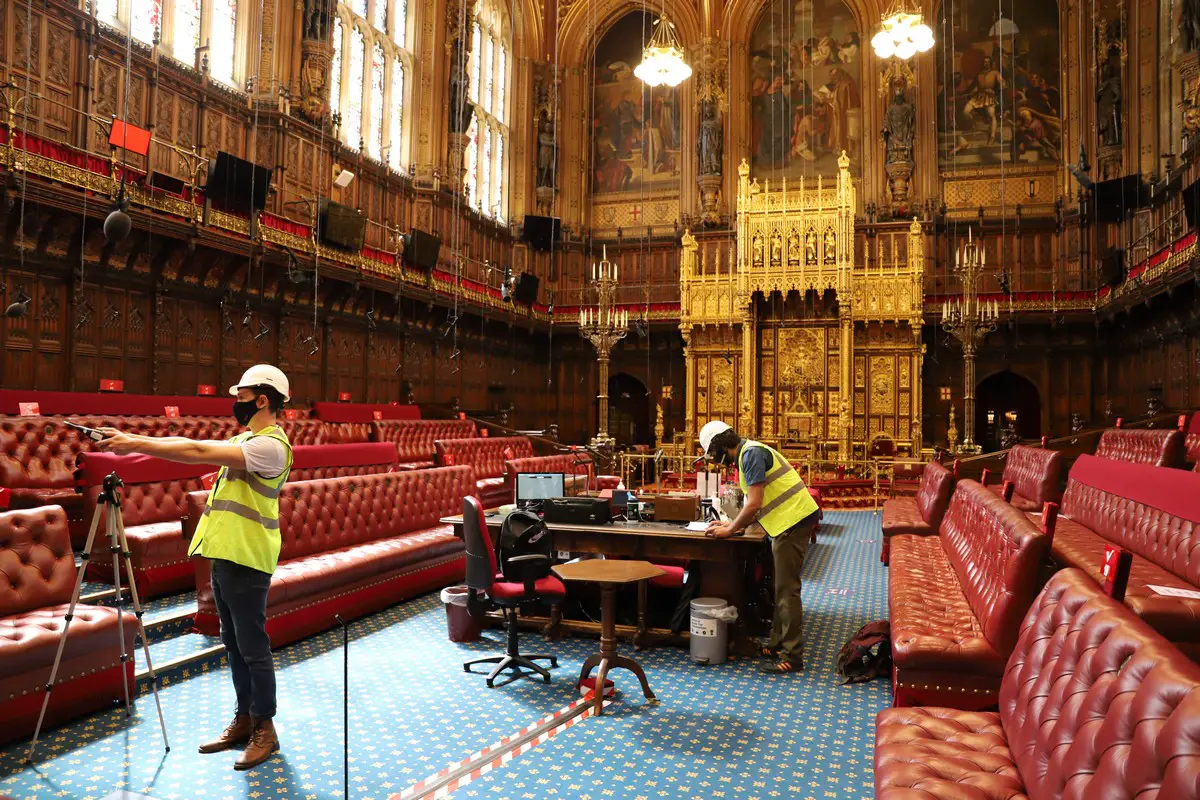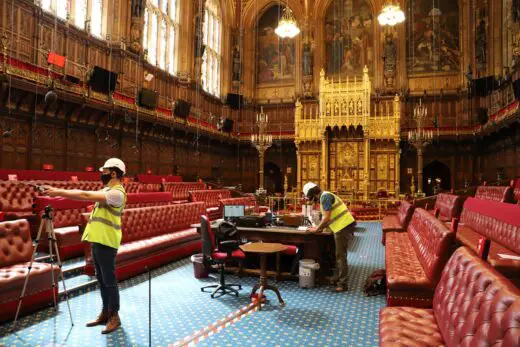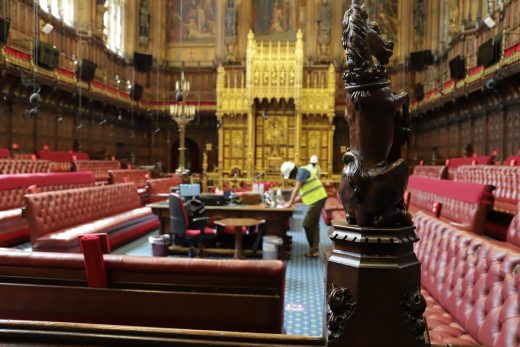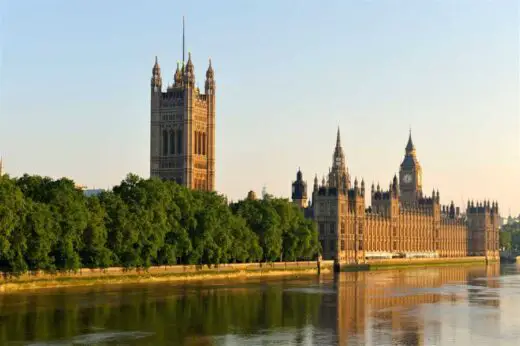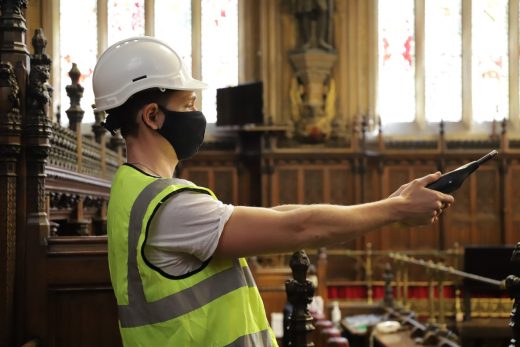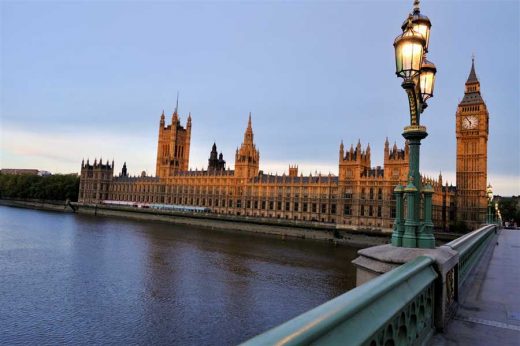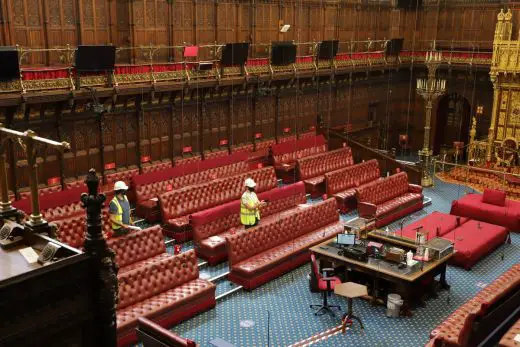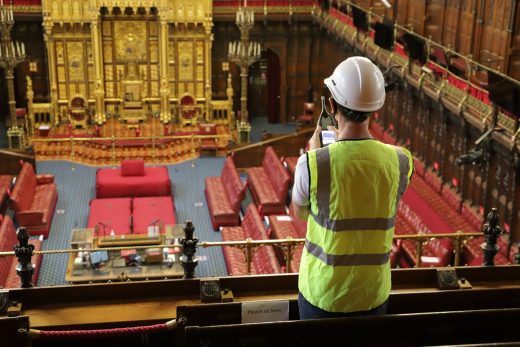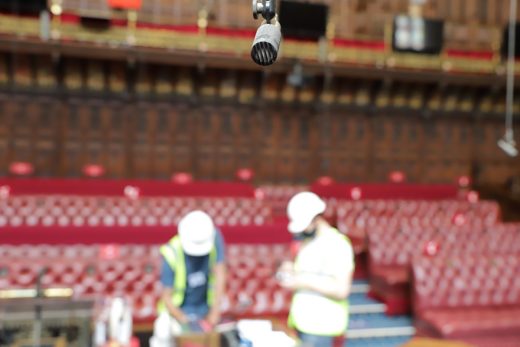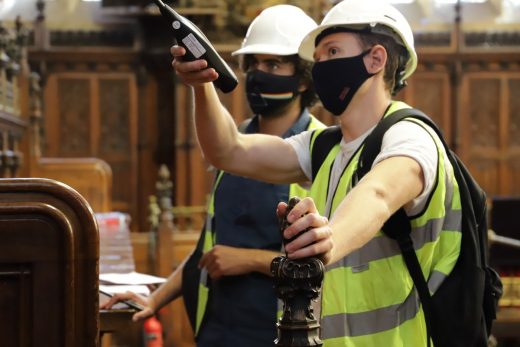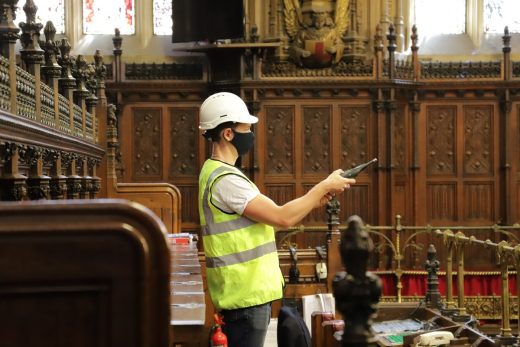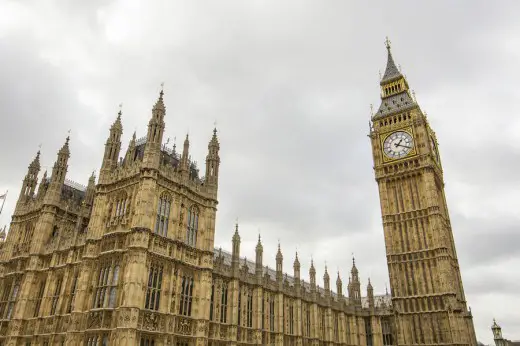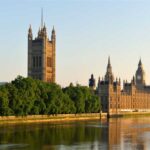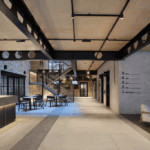Houses of Parliament London Building Restoration, Palace of Westminster Renewal News, Refurb
Palace of Westminster London Restoration
post updated 30 April 2024
Construct Zero’s Five Client Carbon Commitments News
The Houses of Parliament Restoration and Renewal Delivery Authority is proud to sign up to Construct Zero’s Five Client Carbon Commitments to support the UK’s transition to net zero carbon.
Palace of Westminster Carbon Commitments
As a Construct Zero future partner we are committing to:
1. Procure for low carbon construction and provide incentives in our contracts.
2. Set phase out dates for fossil fuel use during construction.
3. Eliminate the most carbon intensive concrete products.
4. Eliminate the most carbon intensive steel products.
5. Adopt PAS 2080, Carbon Management in Infrastructure as a common standard.
Matt White, Restoration and Renewal Delivery Authority Programme Director says:
‘As a major restoration programme, we are committed to playing our part in supporting the low carbon future of the construction industry. We are pledging our support to a series of commitments, including the use of low carbon concrete, green steel and reducing the use of fossil fuels during future construction.’
The Construct Zero pledges relate to activities within the Delivery Authority’s direct control. At this stage in the programme, the pledges within the Construct Zero framework are long-term aspirations for the Delivery Authority, and dependent on future decisions made by Members of both Houses of Parliament on the preferred way forward for R&R.
You can find out more about The Delivery Authority’s net zero carbon commitment and the social value and sustainability approach here Preserving the Past, Protecting the Future.
ConstructZero is an industry change programme launched by the Construction Leadership Council. The goal of the programme is to adopt a cross-industry approach to drive carbon out of all parts of the construction sector.
Houses of Parliament Building Restoration and Renewal Programme
The Palace of Westminster is an internationally recognised symbol of the UK and democracy, and part of a UNESCO world heritage site. Extensive, complex work is needed to restore the Palace. The Parliamentary Buildings (Restoration and Renewal) Act was passed in 2019 to establish the R&R Programme.
Restoring and renewing the Palace will directly benefit the one million people who visit every year and the thousands who work here every day including MPs and Peers, by delivering a greatly improved building, with better accessibility, more reliable services and enhanced health and safety.
All options represent a multi-billion pound, multi-year investment, with no low-cost options. Parliament already spend £1.45m a week to repair and maintain the Palace.
The Palace is enormous, covering 34 acres and with 1100 rooms. There are 65 different floor levels and 100+ staircases. The whole building shares the same water, power, heating, and sewage systems, many of which are 50+ years old and have reached the end of their lifespan. Hundreds of miles of pipes and cables need replacing, and interconnecting voids and ventilation shafts add to the complexity of removing services and managing asbestos.
Work is happening across the Parliamentary estate to ensure the safety of those who work and visit. Currently there are dozens of major projects underway to repair and restore key buildings by in-house teams. All this work is about supporting the continued business of Parliament, by making the estate a safe, resilient, and fit for purpose environment. Background on the Restoration and Renewal Delivery Authority.
The Parliamentary Buildings (Restoration and Renewal) Act 2019 (as amended) established the original mandate to restore and renew the Palace of Westminster. The Act provided for the establishment of the Restoration and Renewal Delivery Authority to design and deliver the restoration and renewal works, overseen, scrutinised and instructed by the R&R Client Team which is a joint department of both Houses of Parliament.
The Delivery Authority also works increasingly closely with Parliament’s Strategic Estates teams, who are responsible for delivering ongoing investment in the Estate ahead of R&R.
In July 2022 Members of both Houses endorsed the Joint Report from the Commissions of both Houses that stated there needs to be a more aligned and integrated approach to future restoration, prioritising safety critical work including:
o Fire safety and protection
o Replacement of mechanical, electrical, drainage and plumbing, and data and communications systems
o Asbestos management and wider health and safety issues
o Conservation of the building fabric including stonework
Members of both Houses also recognised the Parliamentary Buildings (Restoration and Renewal) Act 2019 compels the R&R Programme to have regard to a number of further areas of scope for the works, including:
o The need to ensure the Palace is accessible to people with disabilities
o The need for improved visitor access
o The need to ensure that educational and other facilities are provided for people visiting
o The need to protect the environment and to contribute to achieving sustainable development.
The costed proposals for Restoration and Renewal are due to be presented to both Houses in 2025 and will include detailed information on possible delivery options to support evidence-based decisions by both Houses on the preferred way forward. This will include information on the risks, and mitigations of those risks, involved with delivering each option and robust information on the costs and benefits of each option, to help Members take an informed decision on the preferred way forward for R&R.
As part of costed proposals expected in 2025, three options are being developed:
o A full decant option;
o A continued presence option; and
o A rolling programme of works to deliver enhanced maintenance and improvement
The Delivery Authority is in preliminary market consultation for the future procurement of three long-term Strategic Partners.
The views expressed in this media release are solely those of the sender and do not necessarily reflect the views of Cision.
You are receiving this email because you were included on Restoration & Renewal Delivery Authority Ltd’s media release. To unsubscribe and stop receiving emails from this organisation click here.
Previously on e-architect:
post updated 21 May 2022
Parliament could burn down any day, says Andrea Leadsom
Houses of Parliament Building Fire Risk
Speaking to the BBC, the former UK Government minister Andrea Leadsom said the Houses of Parliament could see a fire similar to the one that damaged the Notre-Dame cathedral in Paris. Parliament needs urgent repair work that could cost between £7bn and £13bn.
A recent report said costs could be kept down if MPs and peers left while the building work was carried out. However, some politicians have expressed concern about moving out and plans to relocate to Richmond House in central London were vetoed.
BBC article on Palace of Westminster Building Fire Risk
22 October 2021
Experts investigate crumbling stonework and hidden cracks in the Houses of Parliament
Palace of Westminster Building Restoration
Crumbling stones, cracking ceilings and warping windows in the Houses of Parliament were the subject of several thousand hours of recent investigations by teams of experts from across the UK, as part of work to plan the essential restoration of the Palace of Westminster.
Over 50 highly skilled engineers, architectural surveyors, acoustics and lighting specialists, and ecologists, spent a combined 4,700 hours over Parliament’s recent recess period investigating the building and continuing to build the most detailed record of the 150-year-old Palace of Westminster ever created.
In total, 2,343 rooms and spaces were examined over the summer and conference recesses, with experts recording thousands of issues including cracks in stonework, widespread water damage, and analysing the complex network of outdated electrical and mechanical systems.
The investigations are an essential step in the restoration and renewal of the Palace of Westminster. Parliament will be invited to approve the detailed restoration plan in 2023.
Jacob Rees-Mogg MP, Leader of the House of Commons, said:
“The Houses of Parliament building is recognised the world over as a symbol of our nation, but this building requires a considerable level of care to keep it working and needs an essential programme of restoration work.
“We must be able to justify this project to taxpayers. That’s why it’s so important to understand and map out the restoration work needed to protect the building – so that the focus is on those essential works necessary to preserve the Palace for future generations.”
Baroness Evans of Bowes Park, Leader of the House of Lords:
“This preparation survey work of the Palace of Westminster is essential to understand the extent and complexity of the programme of works required. In due course it will enable parliamentarians to properly scrutinise the proposed work and ensure value for money.”
Issues were recorded with many of the historic features, including original Victorian stained-glass windows which are warping and sagging due to age. Surveyors also studied the enormous basement and the miles of outdated and interweaving gas, electrics, water, sewage, and heating pipes to get up to date records on the problems that need fixing.
The Palace of Westminster is one of the most loved and recognised buildings in the world, but despite a programme of maintenance works, it’s falling apart faster than it can be fixed and is in urgent need of a programme of essential restoration.
Work was also done to understand the provenance of quirky candle and gas light fittings, some of which were discovered to have been turned upside down when converted to electric power over 100 years ago. Further investigation is ongoing but it is thought the Palace may contain the oldest still-in-use gas lighting system in the world. Several remarkable candle chandeliers that survived the great fire of 1834 which destroyed the original palace were also studied and recorded.
Acoustics experts, considering how to improve audibility within the building, walked 240km, measuring 80 rooms, running 300 individual acoustics tests, taking 2000 measurements.
Experts in ecology and door specialists from Manchester, window surveyors from Glasgow and architects and engineers from across London, in addition to historic surveyors and specialists from Cambridge, Suffolk and Hampshire were involved in the building investigations.
Sarah Johnson, CEO of the Houses of Parliament Restoration & Renewal Sponsor Body, said:
“The essential programme to restore the deteriorating Palace of Westminster will protect our world-famous Parliament for generations to come. These critical and complex investigations are already informing our detailed restoration plan, which will for the first time set out a true sense of the costs and timescales of the much-needed work.”
David Goldstone, CEO of the Houses of Parliament Restoration & Renewal Delivery Authority, said:
“Our specialist investigators and surveyors are spending tens of thousands of hours building the most detailed record of Parliament ever created as we develop the plan for the essential restoration of one of the world’s most famous buildings.”
In winter and throughout next year, even more detailed surveys, including ‘intrusive’ surveys into the structure of the Palace, will be completed to continue building the most detailed record of the Palace ever created.
Parliament’s repair teams run continual maintenance work to ensure people working and visiting the building are safe, but a larger programme of essential restoration work is needed to protect the building for the future.
The Houses of Parliament Restoration and Renewal will create thousands of new jobs and apprenticeships, while boosting both traditional and cutting-edge skills, involving craftspeople and businesses from across the UK in a national effort.
Palace of Westminster Building Facts
Houses of Parliament Building Background facts:
• The Palace of Westminster is a UNESCO World Heritage Site and is one of most recognisable buildings in the world.
• The building is constructed from Anston limestone and has a floorplan the size of 16 football pitches with 1,100 rooms, 100 staircases, three miles of passageways, four floors and 65 different levels.
• The Palace is at high risk of sudden failure from major fire, flood or stone fall. The heating, ventilation, water, and electrical systems are out-dated and steam pipes run alongside electrical cables throughout the building.
• Over 40,000 problems with the building have been reported since 2017.
• In the basement there are 128 plant rooms and 98 risers, only one of which has been fully restored to modern standards. There are seven miles of steam pipes and 250 miles of cabling, all of which need to be stripped out.
• Thousands of ventilation shafts spreading the length and breadth of the building need upgrading to protect against a major fire. A team of fire wardens patrol the building 24/7 to spot and manage fires or incidents which could lead to a fire, and a new water misting system was installed in the last few years.
• It costs £2m a week to keep the building going, with the annual cost of maintenance and ongoing projects recently doubling – rising from £62 million in 2016 to £127 million in 2019, totalling £369m over the four-year period.
• The sewage ejector system installed in 1888 is still in use today.
• Hundreds of miles of cabling need replacing, more than 1,000 spaces contain asbestos, and most of the nearly 4,000 bronze windows need repair.
• The building contains four floors with 65 different levels meaning it is not well designed for people with disabilities and some areas can be very difficult to access.
• There are over 11,000 historic items, including historic furniture, clocks, silver and ceramics, all of which will need to be temporarily removed and taken care of during restoration.
• Parliament already works with specialists across the whole country, for example, sourcing encaustic tiles from Ironbridge; cast iron roof tiles from Halifax, Sheffield, and Chard; limestone from Doncaster and Clipsham; slate from Ffestiniogg, north Wales.
Historical Light fitting observations:
• The light fittings throughout the Palace represent nearly every phase of technology implemented in each decade since construction.
• The highest quality fittings of Augustus Pugin, Charles Barry or George Gilbert Scott have many high-quality replicas, we are researching in detail screw heads and junctions to determine age. Many ages and adaptations exist within each fitting.
• Some gas fittings or armatures / frameworks are still in use having been adapted to electrification or later modified in the 1950s. This also includes many fittings implemented in the first electrification of the 1880s. See attached archive images to see how an early gas light fitting was flipped upside-down when converted to electric to improve light.
• A range of hexagonal fittings have evolved since the 1920s to become the primary aesthetic throughout the palace. We have traced the oldest fittings to be local to the Central Lobby.
• Many Flemish lanterns throughout the dining areas and library corridors are from the 1920s and have greater significance and quality than previously assumed.
• Several large Flemish fittings survived the fire of 1843 and are from the previous Courts of Requests.
• Gas fittings in New Palace Yard are a mix of original installations and some that were put in place later during the reign of George VI, as well as modern refurbishments. These gas fittings could be part of the oldest still-in-use gas lighting in the world.
Other survey information:
• Visual Condition Surveys: These major visual walkaround surveys inspected 2,343 spaces in order to gather information on the condition and structural defects of the building.
• Bird surveys: Assessment of bird presence at the Houses of Parliament, listening and recording birds at peak times of the day including dawn and dusk.
• Ecology surveys: The Victoria Tower has been famous for nesting Peregrine Falcons, where the high level, intricate stonework replicates their natural habitat in an urban setting. This survey looked at the internal roof space voids and plant rooms to look for signs of nesting birds and bats that would need to be identified prior to any construction works taking place.
• Windows Design Study: Experts surveyed and recorded the operation and fixing of some of the nearly 3,000 original windows in the Palace of Westminster, from original Victorian bronze framed windows to magnificent stained glass in Westminster Hall.
• Basement Inspection: Surveyors accessed spaces within the cramped basement to record and view structural arrangements. These visits allowed surveyors a better understanding of the types of works that will be required to renovate and renew critical services in the building, many of which are over 100 years old.
• Door Study: The Palace of Westminster has a wide range of ancient and historic doors that are central to the history of the nation. The survey performed a visual inspection of heritage doors in Westminster Hall, St Stephen’s Chapel, and the Central Lobby to establish materials, finish, and artistic ironmongery. They will be assessed against requirements for fire resistance, security and acoustic properties.
• Room Study: A visual inspection consisting of 20 spaces including the Lords Chamber, Libraries and Westminster Hall. The surveyors reviewed and recorded existing mechanical, electrical and plant details. This survey will allow the surveyors to obtain a better understanding of the types of works that that may be required to service these rooms and the heritage impact.
Houses of Parliament Building Restoration News received 221021
Previously on e-architect:
16 June 2021
Palace of Westminster Restoration Public Views
Parliament restoration programme invites public to share ideas and views on the restoration and renewal of the Palace of Westminster
The Palace of Westminster building viewed across the River Thames from the south:
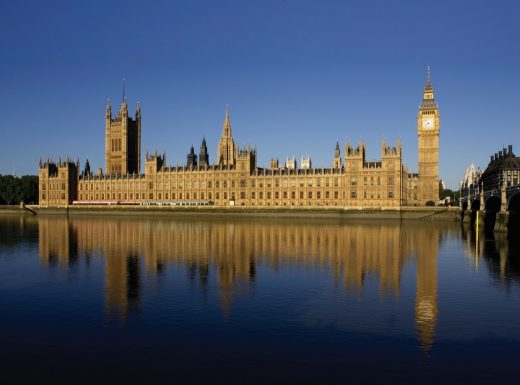
photograph © UK Parliament
Houses of Parliament Restoration and Renewal
26 Mar 2021
Houses of Parliament Restoration Programme
Palace of Westminster Detailed Record
Parliament restoration programme launches nationwide invitation for specialist surveyors to help develop most detailed record of the Palace of Westminster ever created.
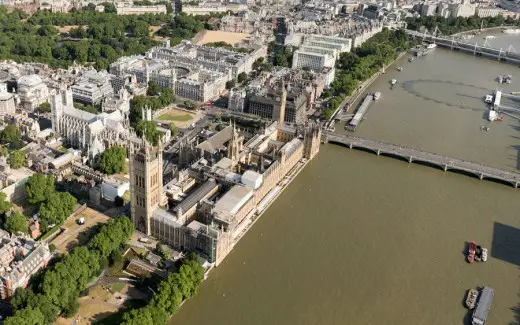
photo courtesy of architects Foster + Partners
Palace of Westminster London Building Restoration
Westminster Hall Restoration
Renovations: Perfect Circle and SCAPE
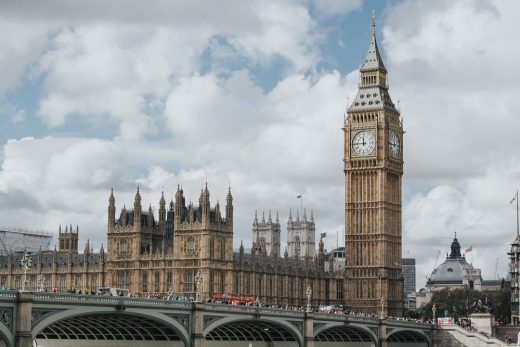
image courtesy of architects practice
Westminster Hall Restoration
Houses of Parliament Building Renewal Contracts
UK Parliament Renewal Contracts awarded to help ensure safe and secure future of Palace of Westminster
British architectural firm BDP win the architectural contract for the Palace of Westminster London Restoration.
Photos © UK Parliament unless stated otherwise
Palace of Westminster London Renewal
Temporary UK Parliament on the River Thames
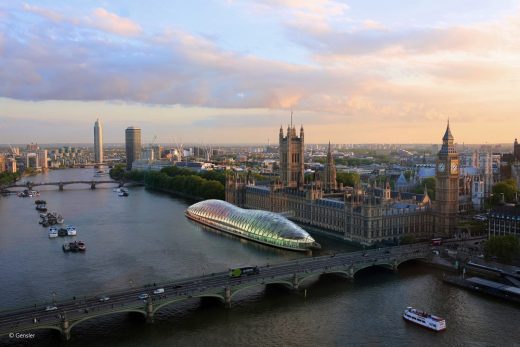
picture © Project Posiedon
Houses of Parliament on the River Thames in London
Houses of Parliament Building
Built: 1840-68
Architects: Barry + Pugin
Large Victorian Gothic Building
Location: Parliament Square, London, SW1, England, UK
Architecture in London
London Architecture Links – chronological list
Houses of Parliament London joint architect : Charles Barry
Architecture Walking Tours London
Comments / photos for the Houses of Parliament Building Restoration News – Palace of Westminster London Architecture page welcome

